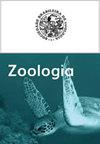Chilling to the bone: Lower temperatures increase vertebrate predation by Tonatia bidens (Chiroptera: Phyllostomidae)
IF 1.8
4区 生物学
Q4 ZOOLOGY
引用次数: 4
Abstract
The greater round-eared bat, Tonatia bidens (Spix, 1823), is a medium-sized phyllostomid bat distributed in the north of Argentina, Paraguay and Brazil. The diet and foraging patterns of this species are poorly known. We analyzed the composition of the diet of a population of T. bidens and how the temperature influences the consumption of vertebrates and invertebrates. To describe diet composition, we conducted weekly collections of food scrap from two monospecific night-perches. Data of temperature for the study period were taken from the meteorological station installed 300 m from the collection perches. The influence of temperature was evaluated using generalized linear models (GLMs) with negative binomial distribution. Tonatia bidens consumed 28 taxons (204 records), being at least 17 Artropods and 11 Passeriformes birds. Temperature explained a greater proportion of vertebrate abundance (R2 = 0.23) than invertebrate (R2 = 0.16) or to both pooled (R2 = 0.11). The relation with temperature was positive with invertebrates and negative with the vertebrates. The diet of the population of T. bidens comprised mainly invertebrates, which were the most frequent and diverse taxa. Data suggests that T. bidens has a diverse diet, with proportion of the item’s consumption varying temporally. Environmental factors, such as the temperature presented on this work, seems to be good proxies for the dietary traits of this species.寒冷到骨头:较低的温度增加了脊椎动物的捕食,如白齿蝶(翼翅目:毛毡虫科)
较大的圆耳蝙蝠,Tonatia bidens (Spix, 1823),是一种中等大小的层状目蝙蝠,分布在阿根廷、巴拉圭和巴西北部。这个物种的饮食和觅食模式鲜为人知。我们分析了一个白毛瓢虫种群的食性组成,以及温度对脊椎动物和无脊椎动物食性的影响。为了描述饮食组成,我们每周收集两种单种夜栖动物的食物残渣。研究期间的温度数据取自距采集点300 m的气象站。采用负二项分布的广义线性模型(GLMs)评估温度的影响。共消耗28个类群(204个记录),其中至少有17种节肢动物和11种雀形目鸟类。温度解释脊椎动物丰度的比例(R2 = 0.23)大于无脊椎动物(R2 = 0.16)或两者混合(R2 = 0.11)。与温度的关系无脊椎动物为正,脊椎动物为负。以无脊椎动物为主要食材,以无脊椎动物为最常见和最多样化的类群。数据表明,大叶瓢虫的饮食多样化,其食物消费的比例随时间而变化。环境因素,如本研究中提出的温度,似乎是该物种饮食特征的良好代表。
本文章由计算机程序翻译,如有差异,请以英文原文为准。
求助全文
约1分钟内获得全文
求助全文
来源期刊

Zoologia
生物-动物学
自引率
0.00%
发文量
15
期刊介绍:
Zoologia, the scientific journal of the Sociedade Brasileira de Zoologia (SBZ), is an international peer-reviewed, open-access Zoological journal that publishes original research on systematics, evolution, taxonomy, nomenclature, biogeography, morphology, physiology, biology, ecology, symbiosis, conservation, behavior, genetics and allied fields. The journal, formerly known as Revista Brasileira de Zoologia, publishes original articles authored by both members and non-members of the Society. The manuscripts should be written exclusively in English.
 求助内容:
求助内容: 应助结果提醒方式:
应助结果提醒方式:


